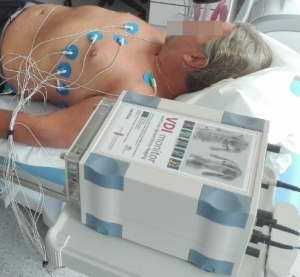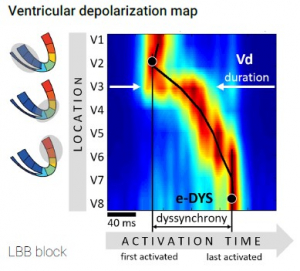Czech high-frequency ECG celebrates another success
The second US patent has been awarded to a team of scientists from the International Clinical Research Center (ICRC) in Brno, the 3rd Faculty of Medicine of Charles University (3. LF UK), the Institute of Scientific Instruments of the Czech Academy of Sciences (ISI CAS) and Cardion s.r.o. They developed a new technology for the device, commonly known by the acronym ECG. The high-frequency electrocardiogram (UHF-ECG) brings more accurate diagnosis to doctors and patients. By reducing the number of inappropriate treatments, it promises cost savings throughout the healthcare system.
In order for the heart to pump blood into the body, there are regular coordinated contractions of the atria and ventricles. These contractions are triggered by electrical impulses. The ECG is one of the basic tests in cardiology. It records the electrical activity of the heart in the form of an electrocardiogram (a time recording of ECG waveforms), which allows for subsequent evaluation. A conventional ECG measures up to approximately 150 Hz. “We have started to observe higher frequencies in conventional ECG measurements, especially in the 150-1000 Hz region, and their behaviour between the different electrodes on the chest. We found that these frequencies can occur at different times in each electrode within the so-called QRS complex, which records the impulse for ventricular contraction. Depending on whether the patient has any defect in the electrical impulse in the heart chambers,” explained Pavel Leinveber, head of the ICRC Biomedical Engineering Centre.
In a healthy heart, both ventricles work simultaneously, i.e. synchronously. In a patient, for example after a massive heart attack, there may be so-called ventricular dyssynchrony, where one ventricle or part of it is activated with a delay. The heart does not pump blood efficiently, reducing its output, which causes considerable health problems for patients. Electrical conduction disturbances in the heart are treated using various pacing techniques. The choice of the appropriate technique and the correct execution of the technique are important factors for the effective function of the heart. Conversely, improperly chosen and implemented pacing can induce ventricular dyssynchrony. UHF-ECG technology offers easily accessible information on the electrical activation of the ventricles, which can be used both for the selection of the appropriate pacing technique and for immediate control of correct pacing directly at pacemaker implantation or during follow-up checks for correct pacemaker function.
Fig. 1: Application of UHF-ECG in practice
The new method promises ease of use for physicians, as it uses conventional ECG electrodes and their standard clinical layout on the patient’s chest. The electrical action of the heart chambers is then clearly visible on so-called depolarisation maps. These are based on the high-frequency signal and illustrate in colour how the electrical excitation moves through the ventricles of the heart muscle. The technical solution is also cheap and easily accessible.
“For patients, the test is non-invasive, with results available within minutes. It provides physicians with completely unique information that could help optimize surgical procedures and pacemaker settings in clinical practice. Patients with an optimally placed and adjusted pacemaker remain physically active longer, which positively affects their health and well-being,” adds Doc. MUDr. Karol Čurila from the Cardiac Centre of the 3rd Medical Faculty of Charles University and the University Hospital Královské Vinohrady in Prague. In addition to the improvement in the health of patients, we can expect their longer working activity and other socio-economic benefits for society.
Fig. 2: Example of depolarization map
Czech scientists have already received a second US patent for their discovery. “Thanks to this, no one can manufacture or sell the device for the duration of the patent, without our consent and a share of the profits”, explains Pavel Jurák from the ISI CAS. This patent extends and protects the methodology required to use UHF-ECG technology in practice. Other patents are also applied for within the European Union. The device is currently being used experimentally by 11 hospitals in the Czech Republic and Europe to confirm its effectiveness. These facilities include St. Anne’s University Hospital Brno and the University Hospital Královské Vinohrady in Prague. The next step is now being taken by the start-up company VDI Technologies, s.r.o., founded in 2022. Its goal is to move the device to clinical use, ensure its certification and subsequent market launch. This will allow the technology to be expanded into everyday medical practice.
More information:
www.medisig.com/vdi/
http://www.isibrno.cz/
www.lf3.cuni.cz
Media Contact:
Ing. Jiří Erlebach, Head of PR and Marketing Department, Spokesperson of FNUSA, tel.: +420 543 182 006, jiri.erlebach@fnusa.cz
Ing. Pavla Schieblová, PR Department, Institute of Public Relations of the CAS, tel.: 734 218 279, schieblova@isibrno.cz
Ing. Marta Reichlová, PR Manager, 3rd Faculty of Medicine, Tel.: +420 267 102 217, marta.reichlova@lf3.cuni.cz



